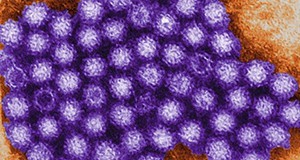Abstract
If you have ever had the stomach flu, norovirus was likely the culprit. Norovirus is the most common cause of foodborne illness in the United States and is transmitted through direct person-to-person contact or contaminated objects and food. This revised 5-page fact sheet covers how norovirus is spread, foods associated with norovirus, symptoms of infection, who is at risk, as well proper sanitation methods for preventing the spread of norovirus. Written by Rachael Silverberg, Melissa K. Jones, Renée Goodrich Schneider, Aswathy Sreedharan, and Keith R. Schneider, and published by the UF Food Science and Human Nutrition Department, June 2015.
FSHN0518/FS129: Preventing Foodborne Illness: Norovirus (ufl.edu)
References
Centers for Disease Control and Prevention (CDC). 2014a. "Preventing Norovirus Outbreaks: Food service has a key role." CDC Vital Signs. Accessed April 3, 2015. http://www.cdc.gov/vitalsigns/pdf/2014-06-vitalsigns.pdf
Centers for Disease Control and Prevention (CDC). 2014b. "Norovirus: Facts for Food Handlers." Accessed April 3, 2015. http://www.cdc.gov/norovirus/downloads/foodhandlers.pdf
Centers for Disease Control and Prevention (CDC). 2015. "Outbreak Updates for International Cruise Ships." CDC Vessel Sanitation Program (VSP). Accessed April 1, 2015. http://www.cdc.gov/nceh/vsp/surv/gilist.htm
Food Standards Agency (FSA). 2011. "Investigation into the prevalence, distribution and levels of norovirus titre in oyster harvesting areas in the UK." Accessed April 7, 2015. http://www.food.gov.uk/science/research/foodborneillness/p01programme/p01projlist/p01009.
Hall, A. J., M. E. Wikswo, K. Pringle, H. Gould, and U. D. Parashar. June 6, 2014. "Vital Signs: Foodborne Norovirus Outbreaks-United States, 2009-2012." Morbidity and Mortality Weekly Report (MMWR). 63 (22): 491-495. http://www.cdc.gov/mmwr/preview/mmwrhtml/mm6322a3.htm?s_cid=mm6322a3_w
Karst, S. M. 2010. "Pathogenesis of noroviruses, emerging RNA viruses." Viruses 2 (3): 748-781. doi:10.3390/v2030748 https://doi.org/10.3390/v2030748
Scallan, E., R. M. Hoekstra, F. J. Angulo, R. V. Tauxe, M. A. Widdowson, S. L. Roy, J. L. Jones, and P. M. Griffin. 2011. "Foodborne Illness Acquired in the United States-Major Pathogens." Emerging Infectious Diseases 17 (1): 7-15. doi: 10.3201/eid1701.091101p1. https://doi.org/10.3201/eid1701.P11101
Schaeffer, J., J. Le Saux, M. Lora, R. Atmar, and F. Le Guyader. 2013. "Norovirus contamination on French marketed oysters." International Journal of Food Microbiology 166 (2): 244-248. http://www.ncbi.nlm.nih.gov/pmc/articles/PMC3955953/ https://doi.org/10.1016/j.ijfoodmicro.2013.07.022
Verhoef, L., J. Hewitt, L. Barclay, S. Ahmed, R. Lake, A. Hall, B. Lopman, A. Kroneman, H. Vennema, J. Vinjé, K. Koopmans. 2015. "Norovirus Genotype Profiles Associated with Foodborne Transmission, 1999-2012." Emerging Infectious Diseases. 21 (4). http://wwwnc.cdc.gov/eid/article/21/4/14-1073_article https://doi.org/10.3201/eid2104.141073
Washington State Department of Health (DOHWa). 2013. "Norovirus in Shellfish." Accessed April 6, 2015. http://www.doh.wa.gov/CommunityandEnvironment/Shellfish/BiotoxinsIllnessPrevention/Norovirus

